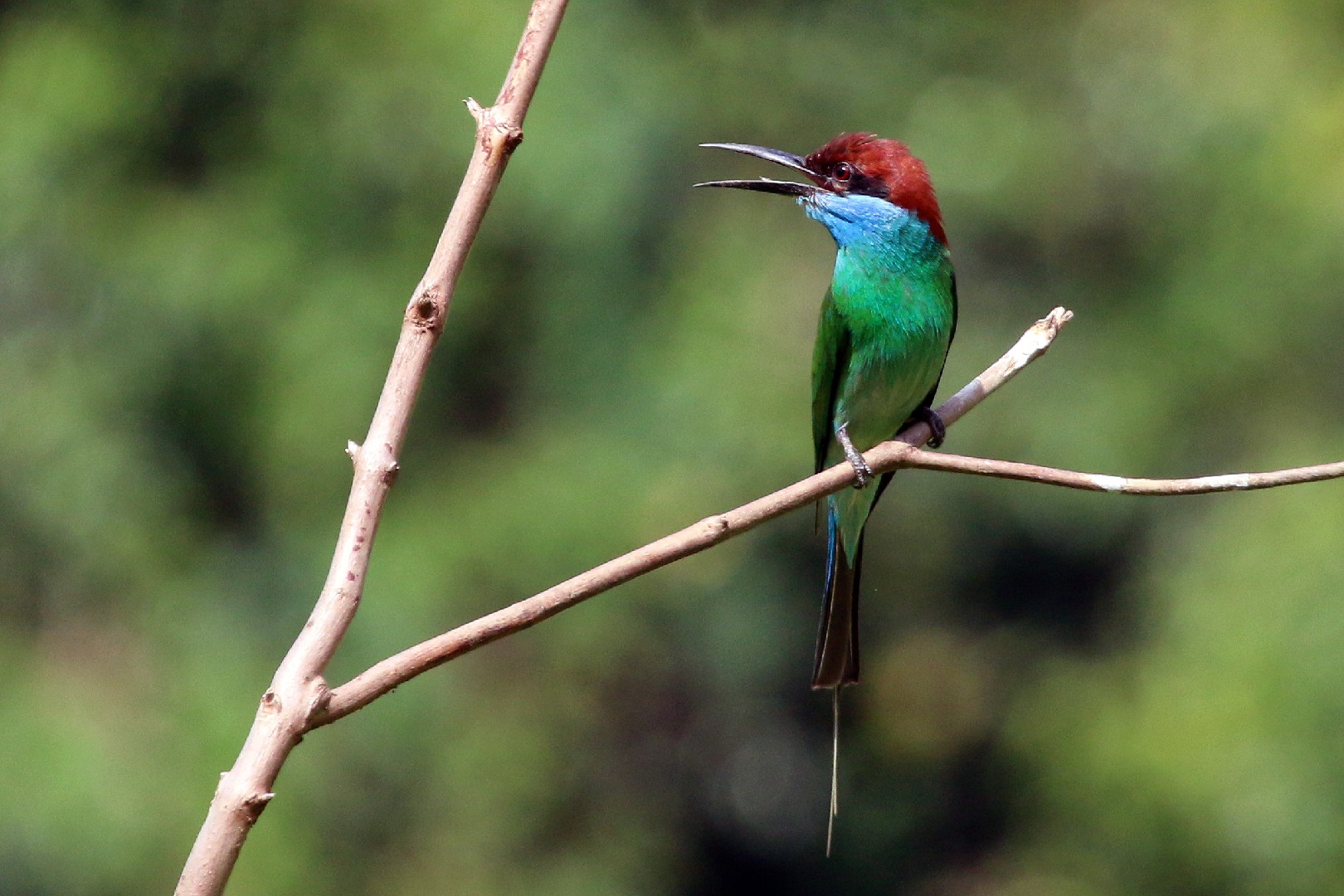Blue-throated Bee-eater
A species of Typical Bee-eaters Scientific name : Merops viridis Genus : Typical Bee-eaters
Blue-throated Bee-eater, A species of Typical Bee-eaters
Botanical name: Merops viridis
Genus: Typical Bee-eaters
 Photo By Charles J Sharp , used under CC-BY-SA-4.0 /Cropped and compressed from original
Photo By Charles J Sharp , used under CC-BY-SA-4.0 /Cropped and compressed from original Description
Adult blue-throated bee-eaters grow to around 21 cm, with an additional 9 cm including tail streamers. They weigh around 34 to 41 grams. Adults have spectacular plumage with a red crown and nape, dark green wings, blue tail, light green breast, white belly, and the signature blue throat. Juveniles develop their full plumage later, with mostly green coloration all over their body. They have a dark green head and wings and light green breast. Both adults and juveniles have black eye patches. Eye color can range between red and brown, or a combination. 
Size
21 cm
Colors
Black
Green
Red
White
Blue
Cyan
Nest Placement
Ground
Feeding Habits
Blue-throated Bee-eater specialize in catching flying insects like bees and wasps, incorporating a variety of bugs into their diet. They exhibit a preference for sunny conditions which increases their hunting success, particularly for dragonflies. Their feeding activity aligns with weather patterns, peaking during the breeding season after the rains.
Habitat
Blue-throated Bee-eater thrives in a variety of lowland habitats up to 800 meters in elevation across southeastern Asia, including beach-front scrub, dunes, pastures, farmland, and suburban gardens. This species is also common along riversides, in sandy clearings, and sometimes in tin-tailings areas. During winter, they can be found in forest canopies and in saltwater channels within coastal mangrove forests. They exhibit flexibility in nesting, with some creating burrows in flat grounds, which can house colonies ranging from 50 to 200 pairs or occurring solitarily in open countries.
Dite type
Insectivorous
Migration Overview
Each spring, blue-throated bee-eaters (Merops viridis) along with blue-tailed bee-eaters (Merops philippinus) migrate from Sumatra, cross the Straits of Malacca, and end up on the west coast of Malaysia. The observed flight locomotion from Tanjung Tuan, west coast of Malaysia, was a combination of flapping and gliding flight. Occasionally, they would use the air currents from the sea-breeze to soar upwards. Once reaching land, they would rest on the lighthouse and tree branches for up to ten minutes before continuing eastward. This migration was observed from 2000 to 2001 with a total of 2,226 bee-eaters, with 1353 blue-tailed bee-eaters, 222 blue-throated bee-eaters, and the rest unidentified. The most observed migrating bee-eaters occurred on 21 March 2000 between 1-2PM. The high number observations of bee-eaters were most likely due to the strong thermals that formed over Sumatra, allowing them to soar over the sea-breeze with ease. High numbers of bee-eaters were also observed to migrate when there were high westerly winds blowing towards Malaysia. Blue-throated bee-eaters also migrate onto breeding grounds of western China during breeding season as shown in the range map above. 
General Info
Feeding Habits
Bird food type
Distribution Area
They have a wide distribution ranging from southeastern China to the Greater Sundas Islands. The most concentrated distribution is found in Singapore, Malaysia, southern Cambodia, and southern Thailand. Other locations with greater dispersal include Borneo and Java. They live in lower elevations between 0–670 meters. Their habitat includes a wide variety of flat plains, such as farmland, suburban gardens, riversides, dunes, and sandy clearings. In the winter, some blue-throated bee-eaters move to forest canopies and saltwater channels of mangrove forests. They often dig burrows horizontally into flat ground, allowing easier access compared to burrows in sand cliffs of other bee-eaters. Colony sizes range from 50 to 200 pairs or living completely solitary in the open country. 
Species Status
Not globally threatened.
Scientific Classification
Phylum
Chordates Class
Birds Family
Bee-eaters Genus
Typical Bee-eaters Species
Blue-throated Bee-eater